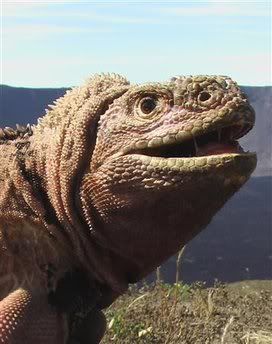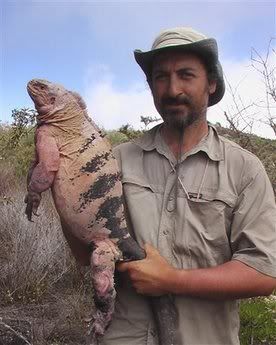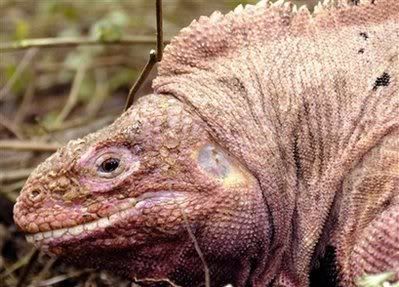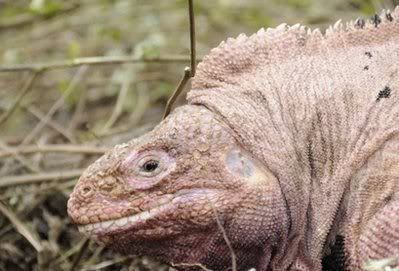- Messages
- 1,922
Jan. 5, 2009 -- When English naturalist Charles Darwin explored the Galapagos Islands in the early 1800s, he, and countless scientists since, overlooked a hefty pink iguana.
The iguana, referred to as "rosada," meaning "pink" in Spanish, has black stripes and is believed to be extremely rare. It was discovered at Volcan Wolf, Isabela Island's northernmost volcano, which Darwin missed during his five-week stay at the archipelago in 1835.
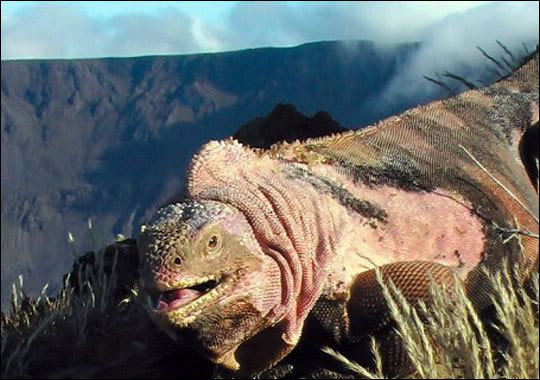
Galapagos National Park rangers first stumbled upon the striking land lizard a few decades ago, but this week's study in the Proceedings of the National Academy of Sciences is the first to officially document the iguana.
"Although 1986 was the year of the first sighting, our work discloses to the world the existence of this new species for the first time," lead author Gabriele Gentile told Discovery News.
Gentile, a researcher in the Department of Biology at Tor Vergata University in Rome, and his colleagues took blood samples from several Galapagos iguanas, including the better-known yellow species. They extracted DNA from the blood to illuminate how the different species are related to each other and when each emerged.
The scientists discovered that the pink-and-black iguana has been around for a very long time.
Based on this study and earlier work, Gentile and his team believe that 10.5 million years ago, a common ancestor to both marine and land iguanas from Central or South America colonized the Galapagos Islands. The marine and land iguanas probably diverged at that time.
Most researchers have thought that all major iguana species differentiated much later during the Pleistocene Epoch (1.8 million to 10,000 years ago). That wasn't so, according to Gentile and his team.
"The pink iguana alters the current thinking about the origin of land iguanas from the Galapagos," he said. "It is the only remnant of an evolutionary lineage that originated from the land iguana lineage much earlier, about 5.7 million years ago, than the Pleistocene, which is when the rest of the present land iguanas started differentiating throughout the archipelago."
The pink iguana has been placed at the very bottom of the archipelago's land iguana family tree. The researchers believe it emerged even before some of the islands in the area fully formed.
Adding to the iguana's eccentricities is the fact that it has unique head scales and a prominent crest. It also bobs its head -- a behavior associated with territory marking and courtship -- in a way distinct from other iguanas.
"The pink iguana shows a particular and distinguished display characterized by multiple series of very rapid ups and downs of the head," Gentile said, adding that a new paper on the bizarre bobbing is in the works.
He and his team also say the colorful iguana should be recognized as "critically endangered" by the International Union for Conservation of Nature Red List, due to hunting by humans, introduction of non-native animals, and habitat loss.
Gisela Caccone, a senior research scientist in ecology and evolutionary biology at Yale University, and her colleagues recently discovered a new species of Galapagos giant tortoise not far from the islands' Charles Darwin Station.
She told Discovery News that "the thing that continues to surprise me is the fact that even in the Galapagos, a place that is the 'Mecca' for evolutionary biologists, we still have undiscovered biodiversity not only amongst small organisms, but even for large vertebrates, as these iguanas are."
Jeffrey Powell, also at Yale, echoed Caccone's view.
"This is one more example that, despite their prominence in the history of evolutionary biology, there is still much to be learned about the fauna and flora of Galapagos," Powell told Discovery News.
<!-- m --><a class="postlink" href="http://dsc.discovery.com/news/2009/01/05/pink-iguana.html" onclick="window.open(this.href);return false;">http://dsc.discovery.com/news/2009/01/0 ... guana.html</a><!-- m -->
